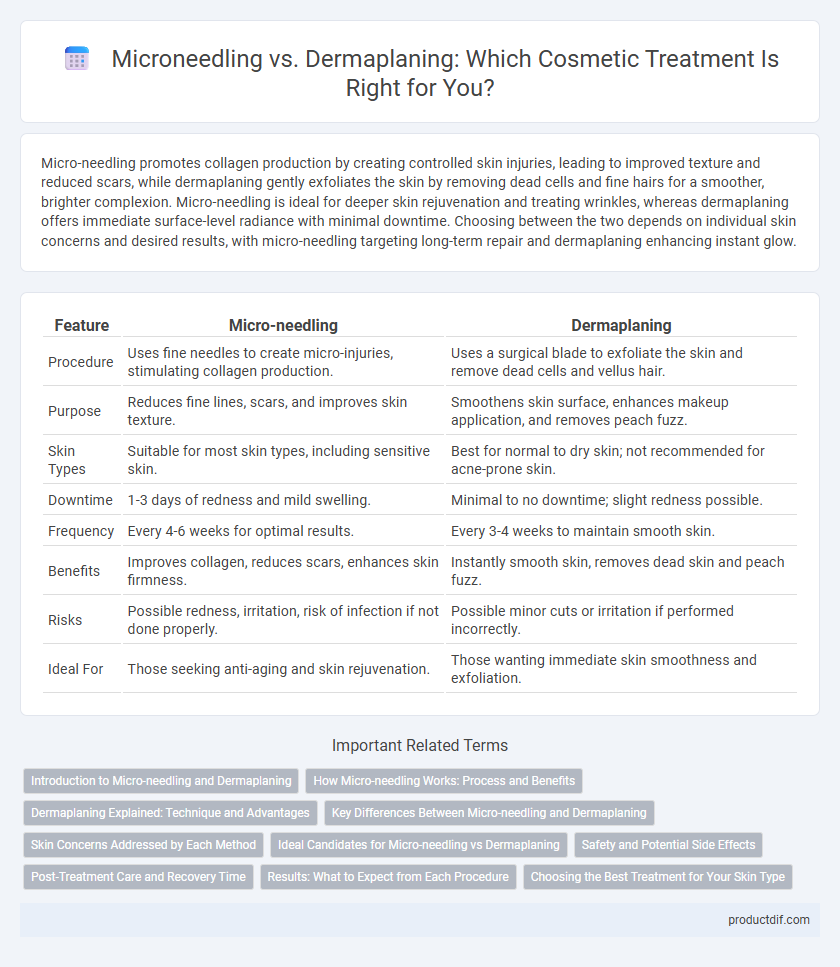Micro-needling promotes collagen production by creating controlled skin injuries, leading to improved texture and reduced scars, while dermaplaning gently exfoliates the skin by removing dead cells and fine hairs for a smoother, brighter complexion. Micro-needling is ideal for deeper skin rejuvenation and treating wrinkles, whereas dermaplaning offers immediate surface-level radiance with minimal downtime. Choosing between the two depends on individual skin concerns and desired results, with micro-needling targeting long-term repair and dermaplaning enhancing instant glow.
Table of Comparison
| Feature | Micro-needling | Dermaplaning |
|---|---|---|
| Procedure | Uses fine needles to create micro-injuries, stimulating collagen production. | Uses a surgical blade to exfoliate the skin and remove dead cells and vellus hair. |
| Purpose | Reduces fine lines, scars, and improves skin texture. | Smoothens skin surface, enhances makeup application, and removes peach fuzz. |
| Skin Types | Suitable for most skin types, including sensitive skin. | Best for normal to dry skin; not recommended for acne-prone skin. |
| Downtime | 1-3 days of redness and mild swelling. | Minimal to no downtime; slight redness possible. |
| Frequency | Every 4-6 weeks for optimal results. | Every 3-4 weeks to maintain smooth skin. |
| Benefits | Improves collagen, reduces scars, enhances skin firmness. | Instantly smooth skin, removes dead skin and peach fuzz. |
| Risks | Possible redness, irritation, risk of infection if not done properly. | Possible minor cuts or irritation if performed incorrectly. |
| Ideal For | Those seeking anti-aging and skin rejuvenation. | Those wanting immediate skin smoothness and exfoliation. |
Introduction to Micro-needling and Dermaplaning
Micro-needling involves using fine needles to create controlled skin injuries, stimulating collagen and elastin production for improved texture and firmness. Dermaplaning uses a sterile surgical blade to exfoliate the outermost skin layer, removing dead cells and fine facial hair for a smoother complexion. Both techniques target skin rejuvenation but differ in method and treatment goals.
How Micro-needling Works: Process and Benefits
Microneedling involves using fine needles to create controlled micro-injuries in the skin, stimulating the body's natural collagen and elastin production for improved texture and firmness. This minimally invasive treatment enhances the absorption of serums and promotes skin regeneration, reducing fine lines, acne scars, and hyperpigmentation. Unlike dermaplaning, which exfoliates the surface, microneedling targets deeper skin layers for long-lasting rejuvenation and repair.
Dermaplaning Explained: Technique and Advantages
Dermaplaning involves using a sterile surgical scalpel to gently exfoliate the skin's surface, effectively removing dead skin cells and fine vellus hair, also known as peach fuzz. This technique promotes smoother skin texture, enhances product absorption, and provides a radiant complexion by encouraging cellular turnover. Unlike micro-needling, dermaplaning is a non-invasive, pain-free procedure with minimal downtime, making it suitable for sensitive skin types and those seeking immediate visible results.
Key Differences Between Micro-needling and Dermaplaning
Micro-needling involves using fine needles to create controlled skin injuries that stimulate collagen production, enhancing skin texture and reducing scars. Dermaplaning utilizes a sterile surgical blade to exfoliate the skin's surface, removing dead cells and peach fuzz for immediate smoothness and brightness. Unlike dermaplaning, micro-needling penetrates deeper layers of the skin, offering long-term rejuvenation benefits rather than just surface exfoliation.
Skin Concerns Addressed by Each Method
Microneedling stimulates collagen production and targets skin concerns like acne scars, fine lines, and hyperpigmentation by creating controlled micro-injuries. Dermaplaning effectively removes dead skin cells and peach fuzz, improving skin texture and brightness, and is ideal for addressing surface-level dullness and fine vellus hair. Both methods enhance overall skin appearance but cater to different issues based on their distinct mechanisms.
Ideal Candidates for Micro-needling vs Dermaplaning
Micro-needling is ideal for individuals with acne scars, fine lines, uneven skin texture, and hyperpigmentation looking to stimulate collagen production and improve skin elasticity. Dermaplaning suits those with sensitive skin, peach fuzz, dry flakes, or superficial debris aiming for immediate smoothness and enhanced product absorption without irritation. Both treatments require a consultation to determine skin type, concerns, and tolerance, ensuring the best personalized approach for optimal cosmetic results.
Safety and Potential Side Effects
Micro-needling involves creating controlled micro-injuries to stimulate collagen production, with common side effects including mild redness, swelling, and temporary pinpoint bleeding, making strict hygiene critical to avoid infections. Dermaplaning mechanically exfoliates the skin's surface using a sterile blade, generally causing minimal irritation but posing risks such as small cuts, redness, or folliculitis if not performed properly. Both treatments require professional application and post-care to minimize adverse reactions and ensure skin safety.
Post-Treatment Care and Recovery Time
Micro-needling requires careful post-treatment care involving gentle cleansing, moisturizing, and strict sun protection to support skin healing and minimize irritation. Recovery time for micro-needling typically spans 3 to 7 days, with possible redness and mild swelling as common side effects. Dermaplaning offers minimal downtime, allowing immediate return to normal activities, with post-treatment care focusing on hydration and sun protection to prevent sensitivity.
Results: What to Expect from Each Procedure
Micro-needling stimulates collagen production by creating tiny punctures in the skin, leading to improved texture, reduced fine lines, and minimized acne scars within weeks. Dermaplaning offers immediate results by exfoliating dead skin cells and removing peach fuzz, revealing smoother, brighter skin with enhanced product absorption. Both treatments enhance skin appearance, but micro-needling provides long-term rejuvenation, whereas dermaplaning delivers instant surface refinement.
Choosing the Best Treatment for Your Skin Type
Micro-needling stimulates collagen production and is ideal for acne scars, uneven texture, and mature skin, while dermaplaning exfoliates dead skin and fine vellus hair, perfect for sensitive or dry skin types. Choosing the best treatment depends on skin concerns; micro-needling targets deeper skin issues, whereas dermaplaning offers immediate surface smoothness and brightness. Consulting a skincare professional ensures the most effective approach tailored to individual skin type and goals.
Micro-needling vs Dermaplaning Infographic

 productdif.com
productdif.com